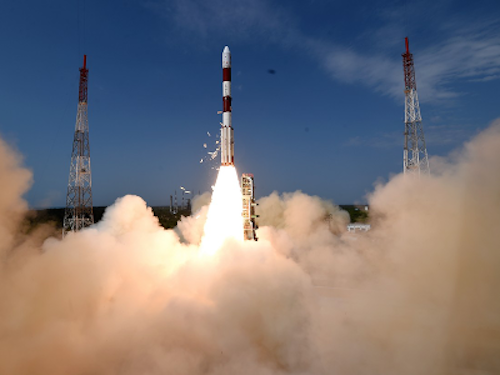31.07.2017
Isro sows seeds of future interstellar missions

NEW DELHI: Remember the 2014 Oscar-winning sci-fi movie "Interstellar", where a group of volunteers travels across the galaxy in search of a new home for humanity? In real life, however, only five Nasa spacecraft have gone beyond the planets of our solar system. Interstellar missions (travelling between stars or planetary systems) remain only in the realms of possibility.
Indian Space Research Organisation (Isro) became part of a global project that will help bring star travel closer to reality, when its PSLV C38 rocket launched six prototypes of tiny interstellar spacecraft, or sprites, into low-earth orbit on June 23 this year.
The good news is that one of these six stamp-sized sprites, which weigh just 4gm and are 3.5cm long, has managed to establish contact with ground stations, becoming the smallest spacecraft ever to do so. It's being seen as a giant step in space technology, with the Isro launch sowing the seed of what could be future interstellar missions.
 Courtesy: Breakthrough Starshot
Courtesy: Breakthrough Starshot
Sprite will help explore deep space mysteries
The six interstellar spacecraft or sprites, launched, are part of an ambitious, multi-million dollar 'Breakthrough Starshot' research project being funded by Russian billionaire and tech investor Yuri Milner and supported by cosmologist Stephen Hawking.
Breakthrough Starshot aims to send a fleet of sprites to Alpha Centauri — our closest star system located about 4.37 light years away from the Earth. Each sprite, weighing just 4 gm, carries with it sensors, solar panels, radio equipment and computers on a single circuit board. The sensors on each circuit board will enable scientists to track their movement in space.
Though India's Cartosat-2 satellite was the main payload of the June 23 launch, the PSLV C38 carried with it 29 nano satellites from 14 countries. The six sprite prototypes piggybacked on Venta and Max Valier educational satellites (two of the 29 satellites).
While Venta-1 is a Latvian satellite built in collaboration with Germany, Max Valier is a nano satellite co-developed by teams of Germany and Italy. Another four sprites are still mounted on Max Valier and await deployment.
Indian Space Research Organisation (Isro) became part of a global project that will help bring star travel closer to reality, when its PSLV C38 rocket launched six prototypes of tiny interstellar spacecraft, or sprites, into low-earth orbit on June 23 this year.
The good news is that one of these six stamp-sized sprites, which weigh just 4gm and are 3.5cm long, has managed to establish contact with ground stations, becoming the smallest spacecraft ever to do so. It's being seen as a giant step in space technology, with the Isro launch sowing the seed of what could be future interstellar missions.

Sprite will help explore deep space mysteries
The six interstellar spacecraft or sprites, launched, are part of an ambitious, multi-million dollar 'Breakthrough Starshot' research project being funded by Russian billionaire and tech investor Yuri Milner and supported by cosmologist Stephen Hawking.
Breakthrough Starshot aims to send a fleet of sprites to Alpha Centauri — our closest star system located about 4.37 light years away from the Earth. Each sprite, weighing just 4 gm, carries with it sensors, solar panels, radio equipment and computers on a single circuit board. The sensors on each circuit board will enable scientists to track their movement in space.
Though India's Cartosat-2 satellite was the main payload of the June 23 launch, the PSLV C38 carried with it 29 nano satellites from 14 countries. The six sprite prototypes piggybacked on Venta and Max Valier educational satellites (two of the 29 satellites).
While Venta-1 is a Latvian satellite built in collaboration with Germany, Max Valier is a nano satellite co-developed by teams of Germany and Italy. Another four sprites are still mounted on Max Valier and await deployment.
Confirming the development, Isro chairman A S Kiran Kumar said, "Venta-1 and Max Valier nano satellites (on which six sprites were mounted) were indeed launched by PSLV C38 on June 23."
Though currently only prototypes of interstellar spacecraft have been launched for preliminary tests, Breakthrough Starshot wants to use lasers to launch the sprites deep into space.
The sprites, once accelerated by laser, will reach up to 15% to 20% of the speed of light. Even with such great speeds, it will take over 20 years for a sprite to reach Alpha Centauri.
Once there, the sprites will capture images of the star and its planet Proxima b, and send images back to Earth. Scientists expect to launch thousands of sprites to study the Earth's magnetic field and atmosphere, and this could become a reality within the next decade.
Quelle:THE TIMES OF INDIA
3340 Views
